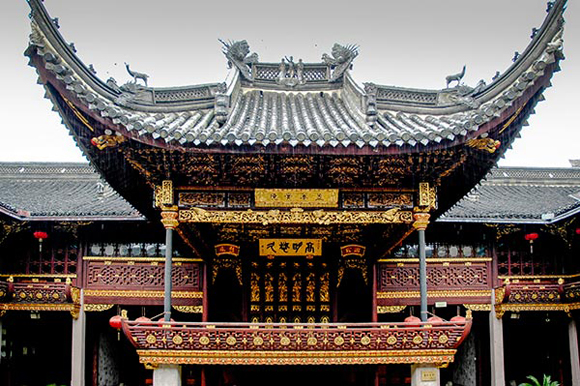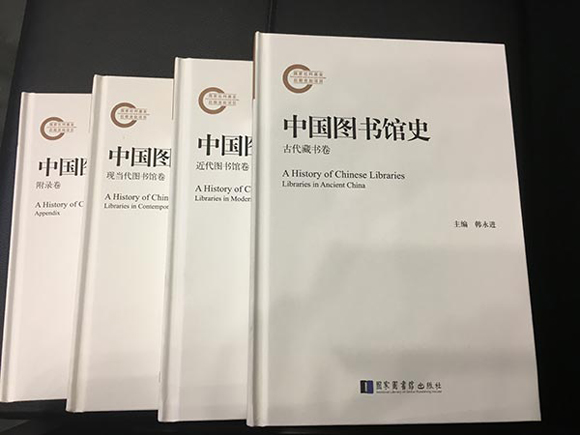
Source: China Daily 2017-10-24 Page 19
http://africa.chinadaily.com.cn/culture/2017-10/24/content_33636238.htm
By Wang Kaihao

Tianyige, in Ningbo, Zhejiang province, is believed to be the country's oldest surviving library. [Photo provided to China Daily]
After seven years' preparation, the first comprehensive history of the nation's libraries was published by the National Library of China earlier this month.
The 2-million-character-long A History of Chinese Libraries travels back more than 3,000 years to discover the origins of Chinese book collections and follows the development of libraries throughout the centuries right up until 2009.
The new book comes in four volumes covering the ancient, modern and contemporary eras, and an additional appendix.
"Uniquely, the book guides readers from ancient times through the ages to the present day using an abundance of references," Han Yongjin, director of the NLC and editor-in-chief of the book, said at its launch at the Beijing institution earlier this month. "It aims to present a fair and panoramic record of how libraries developed in China."
Han says the reason why studies of Chinese libraries in ancient and modern times remained separate for so long was because many scholars considered the notion of a library Western, and ancient Chinese institutions housing books should not be included in the term.
The major argument for this supposition is that while modern libraries have mainly been established to serve the public, ancient Chinese cangshulou (which literally means a building to store books) functioned instead as private study rooms, with their doors firmly closed to the outside.

A History of Chinese Libraries, the first comprehensive history of the nation's libraries. [Photo provided to China Daily]
Royal families, private schools, individual collectors and temples were the four pillars behind developing book collections in ancient China.
This opinion in academia thus attributed the appearance of Chinese libraries in the late Qing Dynasty (1644-1911), with the birth of Western-style public libraries in the country.
"However, many concepts relating to libraries are also applicable to ancient cangshulou, which also collected used books," Han says. "The modern development of Chinese libraries inherits their spirit, just in another form."
Wang Yuguang, a Peking University professor in charge of the volume on libraries in ancient China, admitted that the publishing of this book would not end academic disputes. Nevertheless, he says the contributions made by book collectors on the inheritance of Chinese civilization cannot be doubted.
"Some scholars used to criticize ancient book collectors for being too conservative and not allowing more people exposure to their books, but we generally hold a more positive opinion of them now," Wang says. "Thanks to their efforts, we have a better understanding of these books today."
He also points out that affording more respect to individual collectors serves a more practical purpose these days.
"We still need studies at home to create a relaxed atmosphere conducive to reading," he says. "These will never be replaced by digital books."

The National Library of China in Beijing. [Photo provided to China Daily]
As for the volume covering the modern era spanning the mid-19th century to the founding of New China in 1949, its lead editor Cheng Huanwen, a professor at the Sun Yat-sen University in Guangzhou, described it as a crucial period in the formation of the library system.
Cheng says his panel steered away from making political judgements and maintained a balanced tone in order not to compromise historical accuracy.
For example, early Western contribution to modern Chinese libraries, like those from Christian churches, are also listed in the new book. The volume also outlines the development of libraries in Hong Kong, Macao and Taiwan during their years under foreign rule, something mostly absent from previous academic works on similar topics.
"However, sometimes it's difficult not to get emotional, especially considering that so many libraries were destroyed by enemy forces during the War of Resistance Against Japanese Aggression (1931-45)," Cheng says. "Yet, the choice of some words may still reflect our stance."
The volume on the contemporary era of post-1949 outlines the key achievements made by libraries all over the country in recent decades.
Xiao Ximing, a professor from Wuhan University in Hubei province, says many libraries provided vast numbers of submissions during the writing of this volume, but he adds rigid standards were maintained during the selection process to avoid instances of self-promotion.
Rather than focus on major libraries, more attention was given to showing the history of smaller, lesser-known yet still crucial institutions to help fill in the gaps in other studies, Xiao says.
"This book has monumental significance," says Chen Binbin, deputy director of the public cultural institution department at the Ministry of Culture.
"Through interdisciplinary studies, the book also reflects social changes across China as a whole. The history of libraries is a microcosm of the history of Chinese civilization."
Xiao also hopes the book will help raise public awareness of the need to care for ancient books just as the draft of a new national public library law is about to be submitted for deliberation at next year's National People's Congress, China's top legislature.